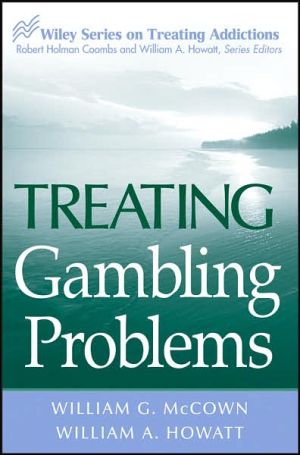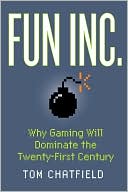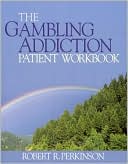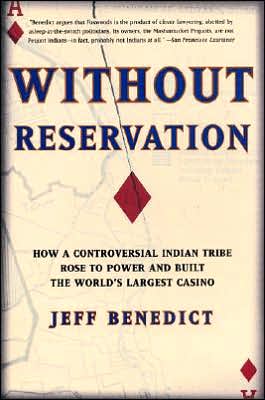Treating Gambling Problems
Full of practical information on assessing, diagnosing, and treating alcohol gambling addiction, this handy manual in the new Wiley Series on Treating Addictions is an invaluable tool for anyone who works with clients experiencing problems with gambling.
Search in google:
The most current and critical gambling addiction treatment approaches—right at your fingertips Legalized gambling is one of the fastest growing industries in the United States. For most of the industry's patrons, gambling is fun and a form of harmless entertainment. Four to six percent of gamblers, however, become pathological or compulsive gamblers, leading to a devastating illness that negatively impacts every aspect of their lives.Treating Gambling Problems helps to bridge the gap between scientific research and practice, pointing the way to a more promising future in the treatment of gambling problems. As part of the Wiley Series on Treating Addictions, this pragmatic, hands-on volume offers up-to-the-minute guidance on effectively diagnosing and treating gambling addiction in every phase. Coverage includes: Risk factors for gambling disordersRecognizing the signs and symptoms of gambling disordersDeveloping effective treatment plansHow to develop a professional referral networkRecovery theories, programs, and toolsPost-treatment recovery management, including relapse preventionSupporting this expert coverage, the reader-friendly series format features quizzes, checklists, "Points to Remember", problem-solving scenarios, suggested resources, and more. Required reading for anyone who works with individuals experiencing gambling addiction, Treating Gambling Problems will equip you with the tools you need to design successful interventions and promote a lasting recovery.Also in the Wiley Series on Treating Addictions:Treating Alcohol ProblemsTreating Drug Problems
Acknowledgments xviiSeries Preface xixPreface xxiAbout the Authors xxivConceptual Foundations of Gambling DisordersIntroduction to Gambling 1Definitions of Problem and Pathological Gambling 5Definitional Distinctions 5An Introduction to the Three Cs of Problem and Pathological Gambling 7Myths versus Facts about Problem and Pathological Gambling 9Transient versus Chronic Problems 11Spontaneous Remission and Maturing Out 13Clinical versus Nonclinical Populations: Why Some Gamblers Do Not Mature Out 14Risk Factors for Gambling Disorders 16Exposure, History, Attitudes, and Expectancies 16Personality Variables 17Blaszczynski's Types 17Specific Contradictory Personality Variables 18Comorbid Psychiatric Disorders 20Biology and Genetic Factors 20Coexisting Addictive Disorders 22Epidemiology of At-Risk Populations 22Gender Differences 24Gambling, the Family, and Multicultural Considerations 25What the Future Holds for the Treatment of ThisDisorder 26Where the Field Is Going 26Summing Up 28Key Terms 29Recommended Reading 30Recognizing Gambling Disorders: Signs and SymptomsDevelopmental Stages in the Progression of Problem and Pathological Gambling Behavior's 33The Gambling Continuum 34Recognizing Gambling Disorders 36The Signs and Symptoms of Pathological Gambling 38Client Information 39Coexisting Addictive Disorder Screening 42Other Client Signs 47What Spouses or Others May Report 49Employers and Supervisors 50Traditional Psychological Assessment 51Complicating Diagnostic Issues 56Healthy versus Problematic Attitudes and Behaviors 59Social Settings 60Professional Collaboration, Accountability, and Responsibility in the Screening-Intake Process 60Summing Up 62Key Terms 63Recommended Reading 64Utilizing Optimal Professional ResourcesReferral Benefits and Disadvantages 68Screening Reports, Documentation, and Responsibility 71How to Develop a Professional Referral Network 72State and National Councils on Compulsive and Pathological Gambling 73Gambling Hotlines 74Liaison with Gamblers Anonymous 75GamAnon 78Psychiatrists and Emergency Facilities 78Matching Clients with the Best Professional Options 79Referrals to Counselors under Contract in the Private Sector 80Referral Do's and Don'ts 81Motivation Strategies and Techniques for Getting a Person to Professionals 83Ambivalence 84Using Motivational Interviewing 85Avoiding Anger and Shame: The Rapid Demotivators 87Procrastination 88Overcoming Client Obstacles 88Common Practical Obstacles 89The "Controlled Gambling Experiment" 90Preventing and Dealing with Crisis Situations 91Family and Concerned Others Involvement 93Risk Management Strategies and Techniques to Protect Clients and Families 94Suicide and Suicidal Ideation 94Six Step Model 96Define the Problem 96Ensure the Person's Safety 96Provide Support 96Explore Options and Alternatives 97Make a Plan 97Get a Commitment 97Risk Management Strategies and Techniques to Protect Counselors 101Duty to Warn for Property Damage 101Referral Follow-Up and Cautionary Notes 103Summing Up 103Key Terms 104Recommended Reading 104Developing an Effective Treatment PlanTherapeutic Benefits of Treatment 108Initial Attrition 110Telephone Contact and Crisis Intervention 112Client Intake 113The Counselor's Tasks During the Intake 115Questions That You Might Need to Ask Yourself 117Helpful Information Before the Intake 117Informed Consent and Limits of Confidentiality 118HIPAA, Intake, and Client Records 123Intake Do's and Don'ts 124Formal Assessment Processes 125Assessment Measures and Instruments Commonly Used and Why They Are Useful 127Diagnostic Processes and Determinations 128Treatment Planning 129Fees and Insurance Coverage 130Managed Care 131Filing for Insurance: The Practice of Responsible Client Billing 131Ethics of Insurance: Modeling Financial Responsibility for the Pathological Gambler 132Family and Concerned Others Involvement 132Recovery Contracts 134Action Plans 135Summing Up 138Key Terms 138Recommended Reading 139Resource for General Paperwork 139HIPAA 139Dual-Diagnoses Clients 140Recovery Theories, Programs, and ToolsAn Overview: What We Know from Other Addictions 143Levels of Traditional Gambling Treatment 145Applying ASA Levels of Care To Gambling Treatment 146Recovery Theories and Models 147The Disease Model 148The Alternative Model 149Motivational Therapies 155Social Interventions 156Medical Treatments 157Responsible Gambling 158Teaching How Video Gambling Works 159Family Therapy 160Psychosocial Therapies 162Insight and Psychodynamic Therapies 163Grief Counseling 164Behavioral Therapies 164Cognitive and Cognitive-Behavioral Models 164Existential and Spiritual Interventions 166Holistic and Alternative Treatments 167Financial Counseling 167Support Groups 167Internet Treatment 171Formal Treatments 172Very Minimal Treatment 172Develop a Gambling Intervention Tool Box 172Workbook and Journaling Programs 173Cultural Pathways of Recovery 175Summing Up 176Key Terms 176Recommended Reading 177Continuing Care: When and How Should Clients Be DischargedRecovery-What Are the Goals? 181Criteria for Exiting Clients from Supervised Treatment 183Discharge Criteria For Different Problem Intensities 184Gambling Problems and Mastery-Based Discharge: Using Cognitive Corrections 185Gambler Discharge or Step-Down Criteria 185Discharge Criteria and Concerns during Various Stages of Recovery 186Discharge and the Developmental Recovery Processes 188Continuing Care Plan Procedures and Guidelines 189Legal, Moral and Ethical Issues 192Proper and Improper Methods of Termination 193Abandonment 194Assessing Community Resources 195Organizing Recovery Supports Where Lacking 196Styles of Recovery: Methods of Disease Management 197Spheres of Recovery 199Family and Concerned Others Involvement and Spheres of Recovery 200Rates of Recovery and Failure 201Summing Up 203Key Terms 204Recommended Reading 204Posttreatment Recovery Management: Models and Protocols of Relapse PreventionRelapse Prevention 208Models of Relapse Prevention 208Behavioral Models of Relapse Prevention 209Cognitive Models of Relapse Prevention 210Cognitive-Behavioral Models 210Belief that relapses are inevitable 211Belief that relapses are impossible 211Belief that God intervenes to allow chance to favor people in need 211Belief that all problems (finance, stress, etc.) need immediate solutions 212Belief that "What did not work in the past will suddenly start to work." 212An Integrated Model of Relapse Prevention 212Baumeister's Model of Self-Regulation 212Proactive Strategies for Preventing and Dealing with "Triggers" for Relapse 213Cognitive Triggers 213Triggers in Cognitive Behavioral Therapy 215Developing Relapse Prevention Plans 216Common Themes in Relapse Prevention 219Emergence of Sadness and Subclinical Depression 219Sleep 220Modification of Social Networks 220Reduction in Other Addictive Substances 221Exercise 221Monitoring and Negotiating Follow Up in Recovery 223Emergency Plans 224Obstacles in Relapse Prevention: Emerging Difficulties 225Emergence of Psychiatric Disorders 225Emergence of Physical Problems 226Emergence of Couples and Family Problems 227Community Linkage as Relapse Reversion Prevention 228Community-Based Vocational Counseling 228Academic Counseling 228Financial Counseling 229Pastoral Counseling 230Leisure Counseling 230Health Counseling 230Telephone and Internet Follow Up 231Family and Concerned Others Involvement during Posttreatment Recovery 232Preventing Chronic Relapses 233Mindfulness 233Summing Up 235Key Terms 236Recommended Reading 236New Beginnings: Moving Beyond the AddictionMoving Beyond 240Recovery in Psychological and Mental Health Domains 241Personality Changes 242Psychotherapies 244Psychodynamic Therapy 244Narrative Psychotherapy 245Humanistic Psychotherapies 246Increasing Positive Emotions and Happiness 248Moral Development 250Beyond Selfhood 251Family Recovery 253Vocational Recovery 255Physical Health and Spirituality 257Summing Up 258Key Terms 259Recommended Reading 259References 261Index 271
\ From the Publisher"Above all, this is a brutally honest, candid book about the treatment of problem gamblers that may have application to the other impulse, addictive, and compulsive disorders. This is a refreshing book, and I recommend it highly to all comers. It should be on everyone's reference shelf and read and reread." (PsycCRITIQUES, February 20, 2008)\ \ \








